
Instrument Flight
Flight Procedures
Localizer Approach
The localizer approach uses the ILS equipment, minus glideslope signal generation equipment. You may
have to perform this approach because of equipment failures in your aircraft, on the ground, or because
the runway lacks a glideslope transmitter. The localizer approach is non-precision with minimums higher
(Figure 44) than a full ILS approach to the same runway. The MAP is determined by timing from the FAF,
by DME, or by radar. As in the ASR, plan your descent so that you are leveled off and on speed prior to
the MAP.
Figure 44: ILS MINIMUMS
Back Course Localizer Approach (BC LOC)
The back course localizer is established along the centerline of a runway in the opposite direction to the
front course.
Caution should be taken when flying a back course LOC approach because of reverse sensing when the
back course is selected in the HSI display. To center the CDI, it will be necessary to steer the aircraft in
the direction opposite the CDI deflection. An alternate procedure is to set the front course into the HSI
display. This will induce a normal sensing display in the HSI display. Again caution should be taken
because the Azimuth Deviation Bar in the ADI display will continue to display reverse sensing.
Whichever procedure is used, a higher level of concentration is required from the pilot to maintain orientation
and fly the approach correctly.
No-Gyro Compass Approach
A no-gyro approach is an ASR/PAR performed when you lose primary heading information. During this
approach, the controller will call your turns by transmitting “turn right/turn left” and “stop turn.” Therefore,
you must perform standard rate turns not to exceed 30 AOB in the pattern and half standard rate turns on
final. A good technique is 30 degrees AOB in pattern, 20 degrees AOB base to final, and 10 degrees on
final (no more AOB than assigned heading change). It is extremely important that you maintain exact turn
rates or wings level attitudes when flying the approach.
BINGO Profile
The bingo profile for the T-45C is defined in NATOPS. During simulator flights, you may be asked to
perform this maneuver. Refer to the NATOPS for all bingo procedures. Note: The bingo profile does not
include fuel which may be required for an instrument approach.
Simulated Minimum Fuel Approaches
On vectors for ILS or in the GCA box, remain in the clean configuration until 30 seconds before glidepath
intercept. Select gear down, flaps to half and speed brakes in while adjusting attitude and power to
maintain required VSI and optimum AOA. Initially, a significant forward stick pressure will be required to
counter the ballooning effect and start the VSI down.
Page 105
(4-01) Original



 Previous Page
Previous Page
